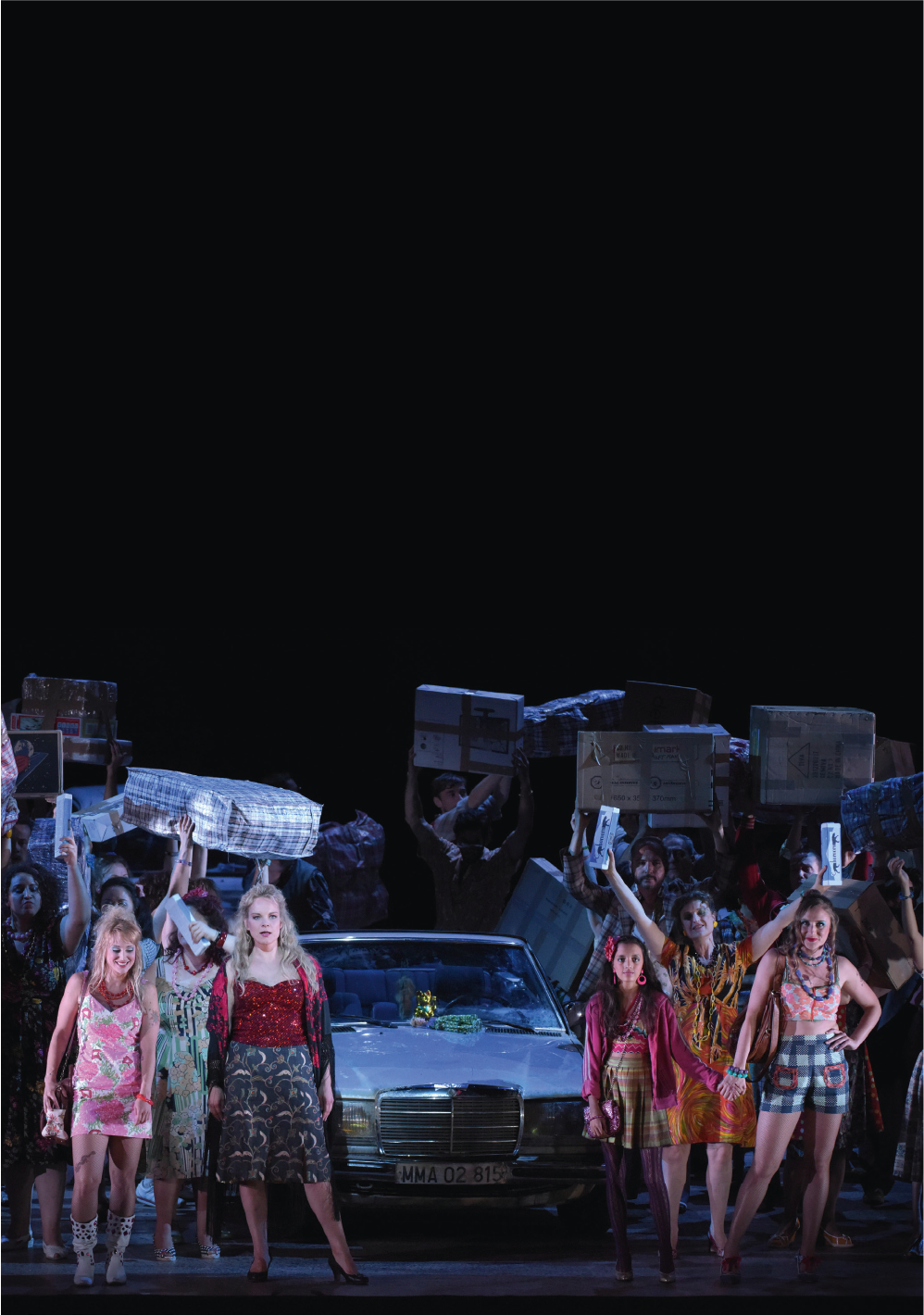With otherness at the heart of the questions raised by Shakespeare’s Othello , how have cinema and its artistic and dramatic devices questioned and rethought the notion of ethnicity?
Othello dramatises the very processes by which ethnic and sexual stereotypes are constructed, disseminated, internalised and questioned culturally. Whether one sees Shakespeare’s play as a text that perpetuates the discourses of discrimination or as one that condemns them, Othello explores the way in which otherness is constructed. The final scene, in which Othello the Moor kills his white wife Desdemona is so terrible that it has provoked the anger of numerous spectators and was rewritten in those French and German translations that preferred to provide a happy ending. In his short film Che cosa sono le nuvole? (1967), Pasolini shows how a performance of Othello can turn into a brawl when the audience, horrified by the way the plot develops, invades the stage, changes the story by saving Desdemona and bravely takes a stand against the patriarchal, racist and sexist authority that seems to underpin the discourse of the play.
Performed for three hundred years by white actors blacked up, Othello bears the weighty burden of a long history of struggle for the right of black actors to play the title role. Ira Aldridge, in the 19th century, was the first black actor to play Othello, followed by the celebrated Paul Robeson in the 20th century. However, giving the role to a black actor can also help to reinforce stereotypes (since the black man plays the murderer of a young white woman). For a long time, cinema also employed white actors for the role until minstrel-style make-up was no longer considered as a convention but as a scandal.
From the time of silent films onwards, cinema adaptations of Othello provide evidence of complex cultural negotiations. The Italian film by Arturo Ambrosio and Arrigo Frusta, which came out in 1914, was censored because of its morbid ending. Paradoxically, however, the film is perhaps the least voyeuristic of all since the murder takes place off-camera, whilst the camera focusses on a candle that goes out, the visual equivalent of Othello’s line: “and then put out the light”. In the 1922 German adaptation by Dimitri Buchowetzki (in which Othello, in an original manner, manages to kill Iago before committing suicide) the very dark make-up of the actor Emil Jannings is nuanced by the intertitles presenting Othello as the noble son of an Egyptian prince and a Spanish princess; but his difference is reinforced by the gesture of Iago who uses the fatal handkerchief to wipe himself after brushing past the Moor.
Other productions accentuate the sado-erotic cruelty of the murder. In Orson Welles’ film (1952) the death of Desdemona (Suzanne Cloutier) is slow and erotic. By means of a sequence of expressionist shots, the young woman becomes fragmented and “cut up”. This film, with its fast pace, its use of light and shade, audacious camera angles and cage, mesh and mosaic motifs reflecting Iago’s objective – ensnaring other characters in his net – has influenced numerous adaptations on an aesthetic level.
Othello, film allemand muet de Dimitri Buchowetzki, 1922, avec Emil Jannings (Othello) et Werner Krauss (Iago) © akg-images
The histrionic performance of a very blacked-up Laurence Olivier in the film by Stuart Burge (1965) puts the accent on Othello’s otherness through his skin colour, a pronounced accent and exaggerated gestures. The film, which was released during the civil rights movement in the United States, has often been perceived as condescending, but that would be to overlook the fact that this version reveals just how damaging this story really is.
In the televised version, made in 1981 by Jonathan Miller fir the BBC, Anthony Hopkins played the character not as a black man, but as a suntanned Mediterranean. However, the North-African option can be just as painful a source of controversy: when the play was adapted for French television by Claude Barma in 1962, just before the end of the war with Algeria, the Algerian origins of the actor Daniel Sorano and the French translation (which replaced the term Moor with negro in several places) highlighted a context of strong racial segregation.
In South Africa, Janet Suzman directed an Othello in 1988 for British television’s Channel Four with the black actor John Kani, in defiance of Apartheid racial policies. A year later, Trevor Nunn filmed his theatre production with the Royal Shakespeare Company with the Jamaican opera singer Willard White in the title role – which goes against what is generally done in opera, that is to say, giving the role to blacked-up white tenors in Verdi’s Otello .
Oliver Parker’s film, released in 1995, is the first
cinema version to offer the role to an Afro-American actor: Laurence Fishburne
whose body becomes visually both erotic and threatening, exploiting the sexual
stereotypes attached to black men. The chess game motif with its black/white
opposition evokes the colonial, imperialist discourse in which Othello is
considered as a servant under the authority of Venice. In this version, Iago
(Kenneth Branagh) is presented as the real director of the action, going so far
as to look at the camera and manipulate it to create fade to black effects. As
in Buchowetski’s 1922 version, Iago generates images in the mind of Othello,
which are shared with the spectators. Othello’s fantasies of his wife in bed
with Cassio become visual sequences in which Iago’s accusations take the form
of photographic truths.
Othello, film d’Orson Welles, 1951, avec Orson Welles (Othello), Suzanne Cloutier (Desdémone) © akg-images / Album / United Artists
Film adaptations of Othello have often resonated with current affairs at the time of their release. Parker’s film (1995) as well as ‘O’ by Tim Blake Nelson (who in 2001 situated the play in a high school in South Carolina with Othello as a star of basketball) have been seen in the light of the scandals and tragedies of the moment, like the trial of O. J. Simpson, the Afro-American footballer accused of assassinating his white ex-wife. The Columbine massacre in Littleton, Colorado actually delayed the release of ‘ O’, so striking was the similarity between the character of Hugo, the equivalent of Iago, solitary and bullied at school, and the real-life assassins
These last two adaptations can, in fact, be seen as exceptions within a recent tradition which, on screen, has attenuated the racial question. Since the end of the nineties, film adaptations by non-English-speaking directors has meant that the focus is less on the black issue. Huapango by Iván Lipkies (Mexico, 2003) and Omkara by Vishal Bhardwaj (India, 2006) put the accent on elements combining social class and ethnicity, whilst Othello: The Tragedy of the Moor by Zaid Shaikh (Canada, 2008) concentrates on religion (Christians against Muslims). This shifting of the play towards other identity issues has made certain critics think that Othello has become a post-racial text. These internationalised adaptations testify to a certain resistance towards an Anglo-American appropriation of Shakespeare and its racialized prism. This change is ambivalent, however: it can be celebrated as a post-colonial sign of tolerance and acceptance but can also be perceived as a troubling obliteration of the racial question, which transforms the play into a simple story about “difference”. Moreover, ironically, at the very moment at which Othello has at last become a role open to black actors, it eludes them once again. By its ambiguities and its complexity, the story of Othello continues over the centuries to reflect issues of identity, whilst also helping to fashion the processes by which those identities are constructed and the way we look at them.
For further reading, see
Shakespeare on Screen: Othello , a collective work directed by Sarah
Hatchuel and Nathalie Vienne-Guerrin (Cambridge University Press, 2015).






























































